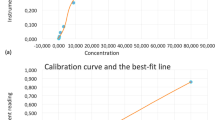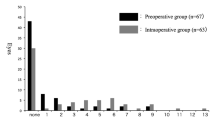Abstract
Purpose
To determine the cytokine levels in vitreous samples of diabetic macular edema (DME) patients in comparison with nondiabetic patients, and to evaluate the effect of subretinal fluid on the cytokine levels of vitreous samples.
Methods
In this prospective case–control study, 11 eyes of 11 patients with DME and subretinal fluid, 11 eyes of 11 patients with DME without subretinal fluid, and 14 eyes of 14 patients who had undergone vitreoretinal surgery for the epiretinal membrane or a macular hole (control group) were evaluated. The blood glycated hemoglobin (HbA1c) level, vitreous vascular endothelial growth factor (VEGF), and interleukin-8 (IL-8) levels were determined.
Results
The vitreous VEGF level of patients in DME groups was significantly higher than the control group (p < 0.001) without significant difference between DME patients with and without subretinal fluid (p = 0.796). The vitreous IL-8 level of DME patients with subretinal fluid was significantly higher than both control (p = 0.002) and DME without subretinal fluid groups (p = 0.019). The blood HbA1c level was significantly higher in DME group with subretinal fluid than those without subretinal fluid (8.7 ± 1.32 and 7.1 ± 1.13%, respectively, p = 0.010). The only significant correlation was between vitreous VEGF level and blood HbA1c level in DME patients without subretinal fluid (r = 0.813, p = 0.002).
Conclusions
IL-8 level in vitreous samples was higher in DME patients with subretinal fluid than those without subretinal fluid, suggesting that inflammation is an important factor in the progression of DME leading to the subretinal fluid formation in diabetic patients.



Similar content being viewed by others
References
Klein R, Klein BE, Moss SE, Davis MD, DeMets DL (1984) The Wisconsin epidemiologic study of diabetic retinopathy IV: diabetic macular edema. Ophthalmology 91:1464–1474
Antcliff RJ, Marshall J (1999) The pathogenesis of edema in diabetic maculopathy. Semin Ophthalmol 14:223–232
Frank RN (2004) Diabetic retinopathy. N Engl J Med 350:48–58
Bhagat N, Grigorian RA, Tutela A, Zarbin MA (2008) Diabetic macular edema: pathogenesis and treatment. Surv Ophthalmol 54:1–32. https://doi.org/10.1016/j.survophthal.2008.10.001
Adamis AP, Berman AJ (2008) Immunological mechanisms in the pathogenesis of diabetic retinopathy. Semin Immunopathol 30:65–84. https://doi.org/10.1007/s00281-008-0111-x
Roh MI, Kim HS, Song JH, Lim JB, Kwon OW (2009) Effect of intravitreal bevacizumab injection on aqueous humor cytokine levels in clinically significant macular edema. Ophthalmology 116:80–86. https://doi.org/10.1016/j.ophtha.2008.09.036
Funatsu HD, Noma H, Tatsuya M, Shuichiro E, Hori S (2009) Association of vitreous inflammatory factors with diabetic macular edema. Ophthalmology 116:73–79. https://doi.org/10.1016/j.ophtha.2008.09.037
Otani T, Kishi S, Maruyama Y (1999) Patterns of diabetic macular edema with optical coherence tomography. Am J Ophthalmol 127:688–693
Özdemir H, Karaçorlu M, Karaçorlu SA (2005) Regression of serous macular detachment after intravitreal triamcinolone acetonide in patients with diabetic macular edema. Am J Ophthalmol 140:251–255
Sohn HJ, Han DH, Kim IT et al (2011) Changes in aqueous concentrations of various cytokines after intravitreal triamcinolone versus bevacizumab for diabetic macular edema. Am J Ophthalmol 152:686–694. https://doi.org/10.1016/j.ajo.2011.03.033
Jonas JB, Jonas RA, Neumaier M, Findeisen P (2012) Cytokine concentration in aqueous humor of eyes with diabetic macular edema. Retina 32:2150–2157. https://doi.org/10.1097/IAE.0b013e3182576d07
Gaucher D, Sebah C, Erginay A et al (2008) Optical Coherence tomography features during the evolution of serous retinal detachment in patients with diabetic macular edema. Am J Ophthalmol 145:289–296
Antonetti DA, Barber AJ, Khin S, Lieth E, Tarbell JM, Gardner TW (1998) Vascular permeability in experimental diabetes is associated with reduced endothelial occludin content: vascular endothelial growth factor decreases occludin in retinal endothelial cells. Penn State Retina Research Group. Diabetes 47:1953–1959
Marmor MF (1999) Mechanisms of fluid accumulation in retinal edema. Doc Ophthalmol 97:239–249
Kang SW, Park CY, Ham DI (2004) The correlation between fluorescein angiographic and optical coherence tomographic features in clinically significant diabetic macular edema. Am J Ophthalmol 137:313–322
Nishikiori N, Osanai M, Chiba H et al (2007) Glial cell-derived cytokines attenuate the breakdown of vascular integrity in diabetic retinopathy. Diabetes 56:1333–1340
Aiello LP, Avery RL, Arrigg PG et al (1994) Vascular endothelial growth factor in ocular fluids of patients with diabetic retinopathy and other retinal disorders. N Engl J Med 331:1480–1487
Murata T, Ishibashi T, Khalil A, Hata Y, Yoshikawa H, Inomata H (1995) Vascular endothelial factor plays a role in hyperpermeability of diabetic retinal vessels. Ophthalmic Res 27:48–52
Murata T, Nakagawa K, Khalil A, Ishibashi T, Inomata H, Sueishi K (1996) The relation between expression of vascular endothelial growth factor and breakdown of the blood-retinal barrier in diabetic rat retinal retinas. Lab Invest 74:819–825
Antonetti DA, Barber AJ, Hollinger LA, Wolpert EB, Gardner TW (1999) Vascular endothelial growth factor induces rapid phosphorylation of tight junction proteins occludin and zonula occludens 1. J Biol Chem 274:23463–23467
Kaji Y, Usui T, Ishida S et al (2007) Inhibition of diabetic leukostasis and blood-retinal barrier breakdown with a soluble form of a receptor for advanced glycation end products. Invest Ophthalmol Vis Sci 48:858–865
Cohen T, Nahari D, Cerem LW, Neufeld G, Levi BZ (1996) Interleukin 6 induces the expression of vascular endothelial growth factor. J Biol Chem 271:736–741
Pfeiffer A, Spranger J, Meyer-Schwickerath R, Schatz H (1997) Growth factor alterations in advanced diabetic retinopathy: a possible role of blood-retina barrier breakdown. Diabetes 46(Suppl 2):S26–S30
Ozdemir H, Karacorlu M, Karacorlu SA (2005) Regression of serous macular detachment after intravitreal triamcinolone acetonide in patients with diabetic macular edema. Am J Ophthalmol 140:251–255
Lee YS, Choi I, Ning Y et al (2012) Interleukin 8 and its receptor CXCR2 in the tumour microenvironment promote colon cancer growth, progression and metastasis. Br J Cancer 106:1833–1841. https://doi.org/10.1038/bjc.2012.177
Aksunger A, Or M, Okur H, Hasanreisoğlu B, Akbatur H (1997) Role of interleukin 8 in the pathogenesis of proliferative vitreoretinopathy. Ophthalmologica 211:223–225
Petrovič MG, Korošec P, Košnik M, Hawlina M (2007) Vitreous levels of interleukin-8 in patients with proliferative diabetic retinopathy. Am J Ophthalmol 143:175–176
Kim M, Kim Y, Lee SJ (2015) Comparison of aqueous concentrations of angiogenic and inflammatory cytokines based on optical coherence tomography patterns of diabetic macular edema. Indian J Ophthalmol 63:312–317. https://doi.org/10.4103/0301-4738.158069
American Diabetes Association (1998) Standards of medical care for patients with diabetes mellitus. Diabetes Care 21:23–31. https://doi.org/10.2337/diacare.21.1.S23
Klein R, Klein BE, Boss SE, Cruickshanks KJ (1995) Wisconsin-epidemiologic study of diabetic retinopathy. XV. The long-term incidence of macular edema. Ophthalmology 102:7–16
Turgut B, Gul FC, Ilhan N, Demir T, Celiker U (2010) Comparison of serum glycosylated hemoglobin levels in patients with diabetic cystoid macular edema with and without serous macular detachment. Indian J Ophthalmol 58:381–384. https://doi.org/10.4103/0301-4738.67044
Acknowledgements
This study was supported by Kocaeli University Scientific Research Project Coordination Unit (KOU-BAP: Project Number: 2014/83-84HD, 2015/49-50HD). Institutional Review Board Approval Number: KOÜ KAEK 2014/155.
Funding
This study was supported by Kocaeli University Scientific Research Project Coordination Unit (KOU-BAP: Project Number: 2014/83-84HD, 2015/49-50HD).
Author information
Authors and Affiliations
Corresponding author
Ethics declarations
Conflict of interest
All the authors declared that they have no conflict of interest.
Ethical approval
All procedures performed in studies involving human participants were in accordance with the ethical standards of the institutional ethical committee with the 1964 Helsinki Declaration and its later amendments or comparable ethical standards. Institutional Review Board Approval Number: KOÜ KAEK 2014/155.
Informed consent
Informed consent was obtained from all individual participants included in the study.
Rights and permissions
About this article
Cite this article
Yenihayat, F., Özkan, B., Kasap, M. et al. Vitreous IL-8 and VEGF levels in diabetic macular edema with or without subretinal fluid. Int Ophthalmol 39, 821–828 (2019). https://doi.org/10.1007/s10792-018-0874-6
Received:
Accepted:
Published:
Issue Date:
DOI: https://doi.org/10.1007/s10792-018-0874-6




